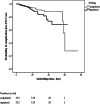Peripherally inserted central venous catheter (PICC) in outpatient and inpatient oncological treatment
- PMID: 31970514
- PMCID: PMC7447660
- DOI: 10.1007/s00520-019-05276-0
Peripherally inserted central venous catheter (PICC) in outpatient and inpatient oncological treatment
Abstract
Purpose: So far there is little evidence on peripherally inserted central venous catheter (PICC) in radiation oncology patients maintaining the access during the periods of ambulatory and hospital treatment.
Methods: A total of 522 PICC placements in 484 patients were performed between 11/2011 and 07/2016 at the Department of Radiation Oncology and analysed retrospectively for complications and treatment- and patient-related factors during ambulatory and hospital inpatient use. On initial hospitalization, all patients received a multimodal radio-oncological treatment consisting of radiation and intravenous therapy administered via the PICC.
Results: A total of 18,292 catheter days were documented. Median follow-up from catheter insertion to their removal was 37 days (1-97). The overall complication rate was 4.1 per 1000 catheter days (n = 75, 14.4%). Complications were similar between the cohort of outpatient 3.6 per 1000 catheter days and the cohort of inpatient 4.8 per 1000 catheter days (OR 0.976; 95% CI [0.598; 1.619]; p = 0.924). Severe bloodstream infections occurred at a rate of 0.60 per 1000 catheter days (n = 11, 2.1%), deep vein thrombosis at a rate of 0.82 per 1.000 catheter days (n = 15, 2.9%) and local inflammation at a rate of 1.26 per 1.000 catheter days (n = 23, 4.4%). Only immunotherapy could be identified as an independent risk factor for complications (OR 5.6; 95% CI [2.4; 13.1]; p < 0.001).
Conclusion: Using PICC in outpatients is not associated with an elevated risk of complications. Particular attention should be payed to early identification of PICC associated bloodstream infections. Immunotherapy is an independent risk factor for local skin complication.
Keywords: Complications; Outpatient and inpatient; PICC; Radio-oncology.
Conflict of interest statement
The study was financed by the budgetary resources of the department of radiology, University Hospital Jena, Germany. The study was neither funded nor sponsored by a third party.
Figures
References
-
- Hans M (2017) Pflegeleitfaden PICC-Line. http://radiologie.charite.de/pflegeleitfaden/
MeSH terms
LinkOut - more resources
Full Text Sources
Medical


